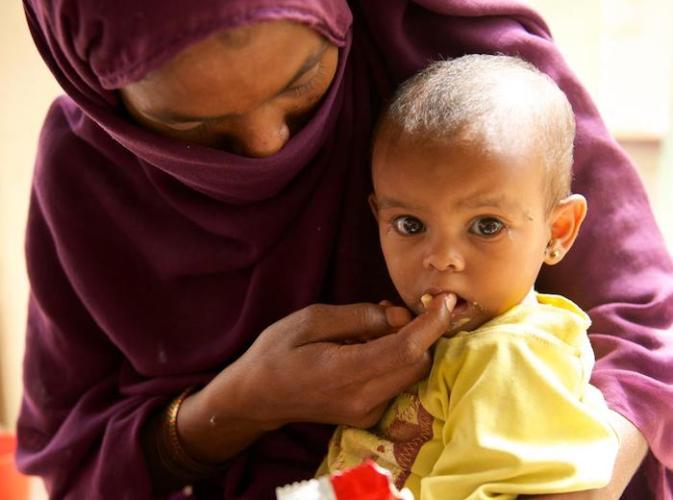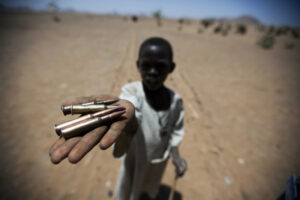Sudan among top four facing global acute malnutrition, as disease outbreaks surge

A mother feeds her one-year-old daughter therapeutic food at a UNICEF-supported nutrition centre in Port Sudan (File photo: Noorani / UNICEF)
The United Nations Office for the Coordination of Humanitarian Affairs (OCHA) has placed Sudan among the top four countries globally for the highest prevalence of global acute malnutrition (GAM). Sudan is facing widespread outbreaks of cholera, dengue fever, and malaria, with hospitals under strain and essential healthcare services disrupted.
Sudan is grappling with a series of interconnected humanitarian crises, as disease outbreaks, acute malnutrition, and widespread displacement worsen amid the ongoing conflict.
Recent nutrition surveys conducted by UN OCHA show that acute malnutrition levels have reached a staggering 13.6 percent, surpassing the World Health Organisation’s (WHO) emergency threshold in 82 percent of monitored areas. This places Sudan in the top four countries in terms of global accute malnutrition, OCHA said in its latest humanitarian update on Tuesday.
Surveys conducted across 18 states have shown alarming malnutrition rates. North Darfur is particularly affected, with some localities such as Um Keddada experiencing famine-level GAM* rates above 30 percent.
The North Darfur Displaced and Refugee Camps Coordination reported on Tuesday a sharp rise in malnutrition across 30 camps in the region. Camps such as Shangil Tobaya, Abu Shouk, Zamzam, and others are suffering from severe shortages of basic necessities due to ongoing violence and clashes in the region.
The statement warned that the ongoing conflict “poses a severe threat to the nation’s unity”, urging the international community to intervene. It called for stronger international pressure to enforce a ceasefire and protect civilians who are deprived of basic rights, warning of the risk of a widespread civil war.
Outbreaks
Compounding the humanitarian crisis, Sudan is battling multiple disease outbreaks, including cholera, malaria, dengue fever, measles, and rubella.
In El Gedaref in eastern Sudan, a camp mainly housing refugees from the Tigray region of Ethiopia reported five suspected cases of mpox, including two Sudanese people.
Residents of Buram, South Darfur, have raised concerns over an outbreak of respiratory infections, which local health officials attribute to the change in seasons. In North Darfur’s El Taweisha, there has been a surge in conjunctivitis cases, with residents resorting to local remedies due to a lack of medical supplies.
Dengue
In Khartoum, the Sharg El Nil (East Nile) Emergency Room has reported a significant rise in dengue fever cases in Soba, registering 118 cases and one death between September 18 and 26. This brings the cumulative number of cases in the region to 194, with 10 deaths since the outbreak began.
The emergency room also raised concerns about the increasing number of fever cases, including 20 patients in critical condition suffering from dangerously low white blood cell and platelet counts. “A lack of diagnostic tools has hindered accurate identification of fever types, with over 243 cases recorded across various health units and neighbourhoods”, it said in a statement on Tuesday.
According to a report by the federal Ministry of Health, the total number of dengue fever cases across Khartoum state has reached 440, with three deaths recorded. The highest concentration of cases has been observed in Karari in Omdurman, and Sharg El Nil. Among the affected are 23 children and 51 women, including a pregnant woman and another with high blood pressure.
Medical workers and volunteers have also been impacted, leading to the partial closure of several health units and community kitchens.
The Alban Jadeed Hospital has been forced to shut down most departments, continuing only emergency and maternity services due to widespread illness among staff and the growing number of patients, especially those affected by malaria and diarrhoea. The scarcity of essential diagnostic tools and treatments, such as intravenous solutions, has further exacerbated the crisis.
The Sharg El Nil Emergency Room urgently called on health organisations to provide immediate support to prevent the situation from escalating into an uncontrollable epidemic. Blood banks are in short supply, and there are fears that “some patients may soon require life-saving interventions that health units are ill-equipped to provide”.
Cholera
The federal Emergency Operations Centre reported on Sunday 197 new cholera cases across three states on Sunday, including eight deaths. The cumulative number of infections has now reached 17,649 across 60 localities in 10 states, with 543 fatalities.
Kassala in eastern Sudan recorded the highest number of new infections, with 109 cases and two deaths. In El Gedaref, the ministry confirmed 99 new cases and one death, raising the total number of infections to over 4,000, with 144 deaths. White Nile state recorded 30 infections.
In Dongola, the capital of Northern State, where infections have surged to 1,100, the town’s Grand Market will close from 15.00, and schools will remain shut. The authorities in Wadi Halfa have also begun importing vegetables and fruits from Egypt as a precautionary measure. Northern State authorities imposed a state-wide curfew to contain the outbreak, from 18.00 until 06.00.
The Ministry of Health in River Nile state reported 46 new cholera cases on Sunday, bringing the cumulative number to 4,434, though no new deaths were recorded.
According to OCHA, more than 17,600 cholera cases and 546 associated deaths have been reported in Sudan the past few months.
* Global Acute Malnutrition (GAM) is an indicator used to measure the severity of malnutrition in children aged 6-59 months within a population. It is calculated as the total percentage of children who are suffering from acute malnutrition, which includes both Moderate Acute Malnutrition (MAM) and Severe Acute Malnutrition (SAM). A GAM prevalence rate of 15 percent or above to indicate a critical humanitarian emergency that demands immediate nutritional and health interventions to prevent mortality and further deterioration of health conditions. (Source: Food Security Cluster)











 and then
and then